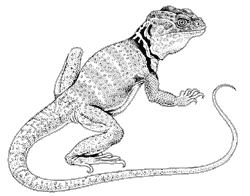Eastern Collared Lizard
(Crotaphytus collaris)
Order: Squamata
Family: Iguanidae (iguanid lizards)
Other common names: mountain boomer
Spanish name: lagartija de collar
Distinguishing Features
This is a medium-sized lizard reaching nearly 10 inches (25 cm) in total length; males are larger than females. The head is large. Two black collars around the neck give the lizard its name. The small body scales have a ground color of tan, bright green, olive, brown, bluish or yellowish with many light spots and dark crossbands. The belly is whitish. Juvenile collared lizards have distinct banding that slowly fades as the animal matures. The adult male is usually very green with dark spots on the throat. Adult females are only slightly green. In breeding season spots and bars of bright red or orange appear on the sides of the female’s body and neck indicating that she is pregnant; these fade after egg deposition. Color varies among the different populations throughout the range.
Range
The collared lizard is widespread throughout the western United States. In the Sonoran Desert, it is found in Arizona, southeastern California, and northern Mexico, including eastern Baja California.
Habitat
Collared lizards are found in rocky areas of a variety of habitats: pinyon-juniper, sagebrush, desertscrub, and desert grassland. They are usually in areas with open vegetation.

Life History
Collared lizards are capable of running swiftly on their hind legs, the body held off the ground at a 45° angle, with tail and forelimbs raised. The stride is up to 3 times the length of the body. They do not lose their tails easily, as they are useful in maintaining balance as the lizards sprint on hind legs. Speed facilitates the capture of prey by these visually oriented lizards. They have large heads with strong jaw muscles that allow them to get a powerful grip on large prey such as lizards. Though fairly bold, if confronted by a predator, collared lizards quickly dive into rock crevices to avoid being eaten.
These lizards often sit on large rocks basking in the sun and looking out for other individuals or food. Males are highly territorial and have stereotypical head-bobbing and push-up displays. Collared lizards primarily eat grasshoppers, but also eat other insects as well as lizards, including their own species. In early summer females lay 1 to 13 eggs; they are capable of reproducing more than once a year. Hatchlings emerge in late summer and early fall.










